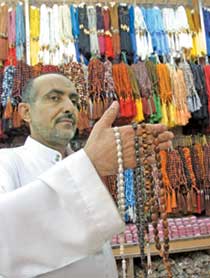PRAYER beads, or masbaha, are more than something to keep idle hands busy or to dangle from the rear-view mirrors of cars, they are used as a tool by which Muslims perform the dhikr, or pronouncements in remembrance of Allah as instructed by the Holy Qur’an.
Essentially, the rope of prayer beads is a kind of abacus used to help memorize verses from the Qur’an or more commonly to keep track of the recitation of the 99 names of God. During the holy month of Ramadan, Muslims’ intimacy with their prayer beads gets closer.
Masbaha can be simple — with beads made from cheap plastic — or they can be decorative and pricey, with beads made from decorative ceramics, hardwoods, precious stones, or the bones of rare animals, such as the rhinoceros.
The string that holds the beads together can be made of cotton, silk or simple nylon. (In the age of machinery, some Muslims have been known to forego the masbaha altogether and use button-operated metal counters.)
While masbaha may vary in style and decorative qualities, they all share similar attributes: Usually a loop of 99 beads divided into clusters of 33, with a shorter string of 10 beads to keep track of multiples and a tasseled rope to mark the start and end of the 99-bead chain. Sometimes the masbaha will be smaller, with only 33 beads, or they can be longer, with 99 beads divided into three groups by three beads that are differently shaped than the rest so that they can be identified by touch. Some are even 999 beads in length, which eliminates the need for the shorter 10-bead string to track the multiples.
The price of the masbaha varies, too, depending on the quality of the workmanship. Some of the fanciest masbaha can fetch prices of up to SR15,000 ($4,000). Prices for modern masbaha can be even higher for beads made from the bones of rare animals. A kilo of rhinoceros bones to make the beads fetches SR25,000 ($6,667) on the black market. (Perhaps killing a rhinoceros for the sake of making personal items is a moral dilemma, but whatever the case: If you ever own one of these items made from rare animal bones, be warned that there is a global ban on transport of items made from endangered-animal parts.) Collectors of antique masbaha have been known to pay up to SR60,000 ($16,000) for old rosaries.
Manufacturers of prayer beads estimate that the Saudi market for masbaha is SR15 million ($4 million) annually with plenty of room to grow. They also say that beads made from animal bones are more popular among people who buy upscale models than the beads made from amber, precious stones or black diamonds. Antique masbaha are also in high demand among collectors.
The history of using memorization aids goes back to the time of the Prophet Muhammad (pbuh). It is said that the Prophet himself may have used simple date seeds, but reports indicate that Caliph Abu Bakr used the masbaha as it is known today. In any case, the widespread use and manufacture of the Muslim rosary began at least six centuries ago.
For more than 66 years people have been making and selling masbaha in the western region of Saudi Arabia. In the beginning of this masbaha boom, prayer-bead makers in this region relied on the materials that pilgrims bring with them during Haj and Umrah. These materials include, precious stones, emerald, and different kinds of threads.
Today, many expatriate workers are now heavily working on making cheap prayer beads from their homes and sell them, competing with Saudi masbaha makers.
Mohammad Hussein, owner of a masbaha shop in Jeddah, said that the demand for quality means that rosaries are imported from places renowned for their craftsmanship, such as Iran, India, Syria and Morocco. According to vendors, the most common and reasonably priced masbaha are made in Syria and cost about SR100 ($34). Iranian prayer beads are also common.
Masbaha gift sets can be purchased and any rosary shop and often include a high quality ink pens. These shops also sometimes sell shumaqs (Saudi headdresses for men) and iqals (the black band used to secure the shumaq), providing one-stop-shopping for fresh threads and accessories for Saudi men.
It seems that the tradition of the religious abacus isn’t fading away like so many other cultural aspect of “Old Arabia”; youths can be seen decorating their souped-up sports cars with the masbaha. Instead of fuzzy dice or air fresheners, they decorate their rear-view mirrors with a rosary. And considering the way some Saudi youths drive, it’s probably a good idea to have a prayer aid within reach of the steering wheel!


